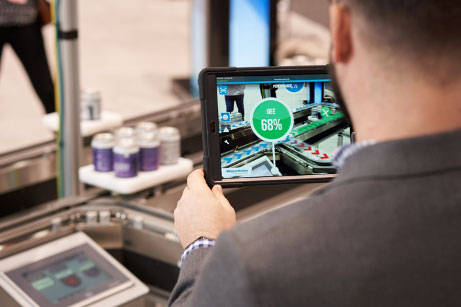Industrial enterprises will leverage real-time, data-driven insights to make more informed, productive decisions.
By Keith Higgins, VP of Digital Transformation, Rockwell Automation
With the IIoT market expected to grow from $77.3 billion in 2020 to $110.6 billion by 2025, 73% of manufacturers plan to increase their investment in smart factory technology over the next year. Below, are some of the critical trends I expect to shape the industry throughout 2021:
As IIoT sensors produce 1.44 billion data points per plant per day, IT/OT integration is critical to improving operational efficiency while accelerating success through digital transformation initiatives. However, enterprises have traditionally been challenged with converting real-time, historic OT data from legacy systems into higher-level IT insights.
Data produced on the factory floor needs to maintain its rich context (such as process conditions, time stamps, machine states, and other production states) to provide maximum insights to factory staff. Previously, aggregating the data generated by machines in processes required significant manual effort and pulling information from many disparate sources. Instead, by automatically capturing high-speed, contextualized OT data from industrial controllers in real-time, organizations can generate predictive insights and operational excellence across the enterprise. By applying context to data pulled from the factory floor, OT teams will create more powerful analytics to better understand the data and how it impacts the machines, lines, plants, and processes they are responsible for. In 2021, IT/OT integration will directly impact whether enterprises remain or become more competitive in the global manufacturing landscape.
For companies scaling smart factory initiatives in 2021, real-time availability of mission-critical workloads will be necessary to ensure business outcomes. Edge computing will complement existing cloud infrastructure by enabling real-time data processing where the work takes place (e.g., motors, pumps, generator, or other sensors). Implementing integrated analytics from the edge to the cloud will help these enterprises maximize the value of investments in digital systems.
The industry will continue to move toward more decentralized compute environments, and the edge will add significant value to digital transformation initiatives. By integrating edge functionalities with existing cloud infrastructure, organizations will worry less about logistical IT considerations and, instead, focus on rethinking what’s possible in a smart machine: What questions can it answer faster? What new problems can it solve? How can it protect operations better? Analysts note that by 2022, 99% of industrial enterprises will utilize edge computing for this reason.
Over the next 12 months, by interconnecting business systems via digital thread, organizations will virtually commission new production lines. Using digital twins, manufacturers will run machines virtually before parts are ordered, discover control issues before support staff goes on-site, predict future performance challenges/opportunity, simulate line changes to keep up with ever-changing customer demands and train new staff on systems without consequence. Gartner estimates that businesses will save US$1 trillion each year in asset maintenance by using IoT through digital twins. IDC suggests that 30% of Global 2000 companies will be using data from digital twins of IoT connected products and assets to improve product innovation success rates and organizational productivity, achieving gains of up to 25%. In 2021, organizations will use digital twins, enabled by digital thread, to solve lifecycle challenges in the digital world before they turn into “if only” moments in the real world, lowering overall manufacturing costs and increasing factory productivity.
Pandemic promotes AR training as the new standard for a distributed workforce
About 70% of manufacturers say the biggest impacts of robotics on the workforce in the next five years will be an increased need for talent to manage in a more automated, flexible production environment and the opening of new jobs to engineer robotics and their operating systems. Since on the job training is no longer possible due to social distancing requirements, manufacturers will fill the gap with remote training tools, such as augmented reality (AR) and 3D-based work instructions, to allow workers to train with experts remotely and optimize capture and delivery. Using advanced technologies to train workers will enable them to analyze performance in real-time, troubleshoot issues more quickly, improve productivity, and avoid significant downtime for unforeseen repairs. This will ultimately make the manufacturing workforce more connected and data-driven, narrowing the skills gap while avoiding safety and compliance risks.

Using advanced training technologies, manufacturing can troubleshoot issues more quickly and improve productivity.
With the IIoT expected to add $15 trillion of value to the global economy by 2030, we can expect industrial enterprises to mature digital transformation efforts over the next 12 months to further improve business outcomes. Manufacturers who leverage data to make real-time, informed decisions, take advantage of digital twins to simulate evolving conditions, and use advanced technologies to upskill its workforce will ultimately see digital initiatives improve its bottom line in 2021.

Keith Higgins
Keith Higgins is Vice President of Digital Transformation at Rockwell Automation. He previously served as Vice President at FogHorn and CMO at RiskVision until its acquisition in 2017. Higgins was also an executive at Symphony Teleca Corporation, an IoT and connected services company, where he played an integral role in the doubling the company’s revenue leading to a nearly $1 billion acquisition by Harman.
Contact: rockwell@10fold.com
In this episode, I sat down with Beejan Giga, Director | Partner and Caleb Emerson, Senior Results Manager at Carpedia International. We discussed the insights behind their recent Industry Today article, “Thinking Three Moves Ahead” and together we explored how manufacturers can plan more strategically, align with their suppliers, and build the operational discipline needed to support intentional, sustainable growth. It was a conversation packed with practical perspectives on navigating a fast-changing industry landscape.